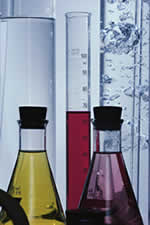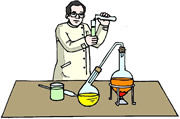Week 2 - Properties of Mixtures and Fluids Using the Particle Model
| Site: | MoodleHUB.ca 🍁 |
| Course: | Science 8 LearnNet |
| Book: | Week 2 - Properties of Mixtures and Fluids Using the Particle Model |
| Printed by: | Guest user |
| Date: | Monday, 17 November 2025, 5:49 PM |
Description
Week 2 - Properties of Mixtures and Fluids Using the Particle Model
1. WHMIS
|
|
Textbook ReadingsScience Focus 8
|
|||||||||||||||||||||||||||
|
|
Background Information Open the WHMIS Symbol Chart.
At this point in your school career, you likely be dealing with materials that are safe to handle. However, you should become familiar with the following WHMIS symbols. As you enter the workforce it is very important that you understand how to handle hazardous materials safely.
|
|||||||||||||||||||||||||||
|
Activities
|
Workplace Hazardous Materials Information System Materials: 1. Draw a data chart, similar to the one shown below, in your notebook.
2. Click here to open the WHMIS Symbol Chart. 3. Study the photographs depicting people in different businesses or industries.
4. Use prior knowledge, the Internet, or other resources to identify one hazardous or controlled substances that might be associated with each business or industry. Record this substance in your data chart. 5. Use the WHMIS Symbol Chart to predict the symbol that might be associated with this substance. Draw the standard WHMIS symbol on your data chart. 6. Play the WHMIS Game (bottom of page). Match the WHMIS symbol to the appropriate description. The game has 4 levels. Answer the question correctly at the end of a level to advance to the next one. Review the symbols before you start: |
|||||||||||||||||||||||||||
Exercise 2.1
|
Check Your Understanding
|
|||||||||||||||||||||||||||
Copyright © 2003 Alberta Learning |
||||||||||||||||||||||||||||
2. Pure Substances, Mixtures and Solutions
|
|
Textbook Readings ScienceFocus 8 Pure substances, mixtures and solutions are all important types of substances. Read on to learn more. |
|
|
Background Information In our experience with our everyday world, we see many different kinds of substances. Let's consider three substances that we may see often - a glass of distilled water, muddy river water and clear ocean water. These are all forms of water, but likely only one of them is one you would like to drink. |
|
|
Experiment Time: Chromatography When you have completed your notes, do the experiment given in the link to a "Yes Magazine" article below. This experiment shows how the separation method of chromatography can be used in crime (forensic) labs.
|
Copyright © 2003 Alberta Learning |
|
3. Pure Substances, Mixtures and Solutions (continued)
|
|
Textbook Readings ScienceFocus 8 In the previous lesson, you learned that clear ocean water is a solution. One of the dissolved materials in ocean water is salt. You might begin to wonder how much salt can dissolve in water. Does temperature matter? Does everything dissolve in water? These and many more questions will be answered as you examine closely what solutions are all about. |
|||||||||||||||
|
|
Background Information As you read your text did you notice that there are many new terms. Be sure to define all of the following terms:
|
|||||||||||||||
|
|
Experiment Time:
In this lesson, you are asked to do one type of calculation - that is how to calculate the concentration of a solution in g/mL. An example follows:
To solve this type of question, simply divide the mass of the solute by the volume of the solvent. 5 g sugar/ 250 mL coffee = 0.02 g/mL Thus the concentration of sugar is 0.02 g/mL |
|||||||||||||||
 Exercise 2.3
|
|
|||||||||||||||
Copyright © 2003 Alberta Learning |
||||||||||||||||
4. Introduction to Viscosity
|
|
No Textbook Readings for this lesson
A measure of the tendency to flow is viscosity. Viscosity is a concept that is roughly equivalent to the term "thickness". Water flows readily because it is thin (or less viscous), syrup flows more slowly because it is thicker then water (or more viscous) and tar is even slower because it is very viscous. Basically a high viscosity means that it flows (or pours) slowly. |
||||||
|
|
Background Information The Particle Theory According to the particle theory, all matter is composed of smaller particles which are always moving (See lesson 1 for a review of the particle theory). These particles have attractions for each other. It is the attractions between molecules that causes viscosity.
This force or attraction is called friction. When a fluid pours, the force of gravity pulls down but the force of friction works against gravity. The forces of friction between the particles in some fluids are stronger then in other fluids. If the force of attraction is very strong, the liquid will pour slowly compare to a liquid with weaker intermolecular attraction. |
||||||
|
Activity
|
Experiment Time: Aim: To study the viscosity of liquids Materials:
Method: 1. Measure exactly 125 ml (or 1/2 cup) of molasses into a clear measuring cup. 2. Slowly pour the molasses into the bowl. Record the time required to pour the molasses. 3. Measure exactly 125 ml (or 1/2 cup) of water into a clear measuring cup. 4. Slowly pour the molasses into the bowl. Record the time required to pour the water. Observations: Prepare a table to record your results. |
||||||
|
Exercise 2.4 
|
|
||||||
Copyright © 2003 Alberta Learning |
|||||||
.
6. Unit 1 Section 2 Quiz
Unit 1 Section 2 Quiz
You will have two opportunities to write this section quiz. This quiz consists of 10 questions. Use the results from your 1st attempt to help you prepare for your second attempt. Your best score will be taken as your assessment mark. You have 10 minutes to complete this multiple choice quiz.























 You have dissolved 5 grams of sugar in your 250 mL cup of coffee. What is the concentration (in g/mL) of sugar in the coffee?
You have dissolved 5 grams of sugar in your 250 mL cup of coffee. What is the concentration (in g/mL) of sugar in the coffee?








